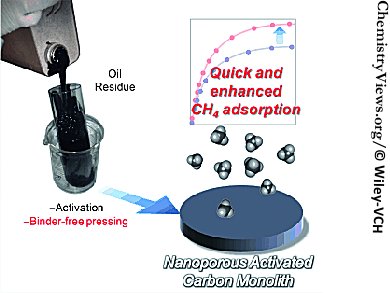CH4, the main component of natural gas, is regarded as a highly promising alternative to nuclear power because it is the cleanest energy source among hydrocarbons and is stored in huge amounts as shale gas and methane hydrate. Adsorption is a good option for the safe and low-energy storage of CH4 if efficient adsorbents are available. Activated carbon (AC) is one such promising candidate.
Katsumi Kaneko, Research Center for Exotic Nanocarbons (JST), Shinshu University, Nagano, Japan, and colleagues prepared nanoporous ACs in monolithic form without binder from ethylene tar and vacuum residue. These newly developed nanoporous carbon monoliths have pore widths of almost the bimolecular size of CH4 (0.74 nm) and show superior advantages over traditional activated-carbon powder.
They have a higher electrical conductivity than the powder forms. This is promising for the high density storage of CH4 per unit volume with an efficient leakage function of the heat of adsorption. The enhancement effects can be accounted for by the better contact between the graphitic nanounits in the monolith. Although one of the expected drawbacks of the monolithic form as an adsorbent is the lower diffusion of adsorbed molecules owing to the densely packed structure of the monolith, the monolithic form has a slightly smaller adsorption rate.
The newly developed carbon monoliths without a diffusion-barrier effect are promising for CH4 storage materials. However, still carbon monoliths that have single graphene nanounits for larger adsorption capacities need to be prepared.
- Diffusion-Barrier-Free Porous Carbon Monoliths as a New Form of Activated Carbon,
Takashi Kubo, Hirotoshi Sakamoto, Toshihiko Fujimori, Tsutomu Itoh, Tomonori Ohba, Hirofumi Kanoh, Manuel Martínez-Escandell, José M. Ramos-Fernández, Mirian Casco, Francisco Rodríguez-Reinoso, Koki Urita, Isamu Moriguchi, Morinobu Endo, Katsumi Kaneko,
ChemSusChem 2012.
DOI: 10.1002/cssc.201200234




